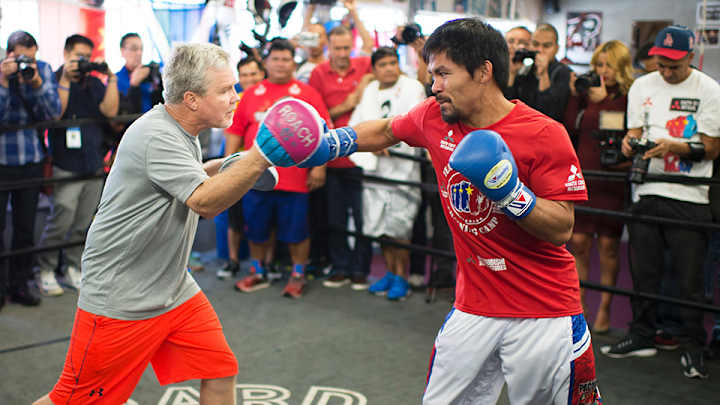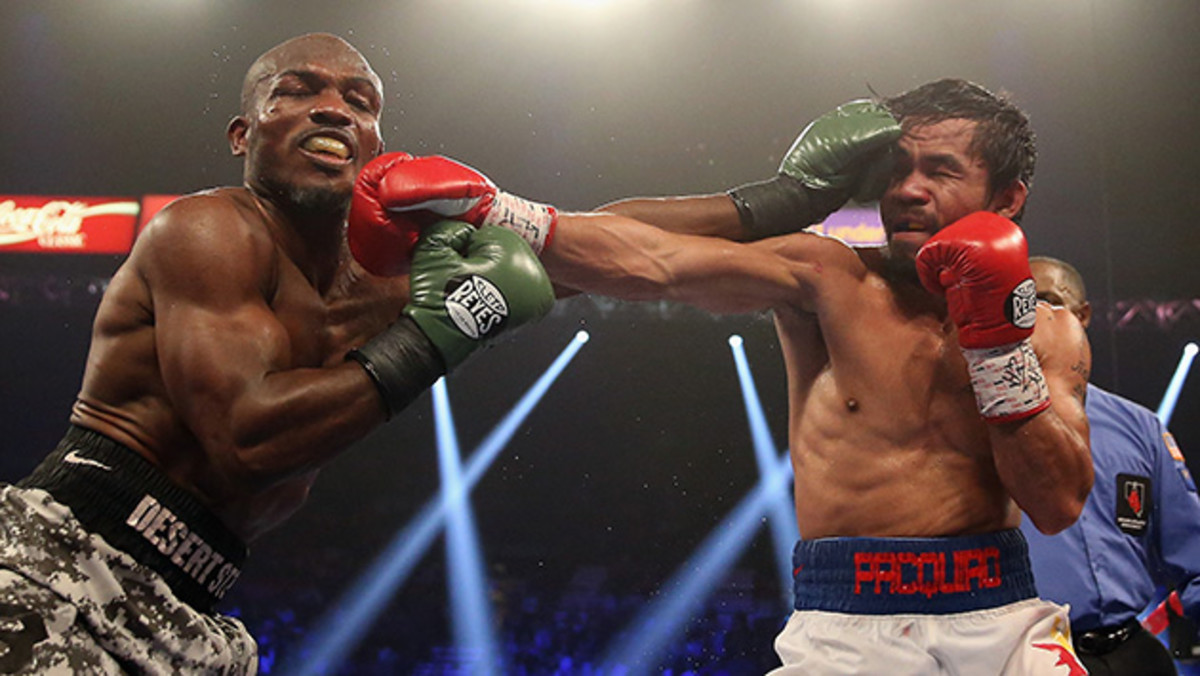Nearing the end of his career, Manny Pacquiao reflects on the beginning

Get all of Greg Bishop’s columns as soon as they’re published. Download the new Sports Illustrated app (iOS or Android) and personalize your experience by following your favorite teams and SI writers.
HOLLYWOOD, Calif. — To ready himself for his third encounter with Tim Bradley, set for April 9, Manny Pacquiao decamped last month to the Wild Card Boxing Club, same as always. His preparations looked and felt familiar. He worked the mitts with Freddie Roach, his longtime trainer. He stretched and pounded the heavy bag and ran at Griffith Park.
But everything is different now, and not even Pacquiao will deny that. This time last year, he was readying to face Floyd Mayweather Jr. in the most lucrative and most watched fight in boxing history. Wild Card was so packed that four security guards patrolled the parking lot. Camera crews followed Pacquiao from the moment he woke up until the moment he turned in. Nike still paid Pacquiao to wears its famous Swoosh. And the widespread condemnation from gay rights groups still lay in the future, to come crashing down on Pacquiao after his statement in a television interview this spring that aired in his home country of the Philippines—that gay people were “worse than animals.”
Everything is different now. Nike dropped Pacquiao. The Grove, a popular mall in Los Angeles, banned him. HBO called his statements “deplorable” and “offensive.”
At Wild Card last month, only the loyalists remained, only the true confidants that have been with Pacquiao since he arrived in California in 2001. Like Roach and head of security Rob Peters and Pacquiao’s best friend, Buboy, and brother, Bobby. They watched him spin through the same routine: the stretching, the mitt work, the heavy bag, the speed bag. They ate with him at Nat’s, the Thai restaurant that Pacquaio still frequents near the gym.
The SI Extra Newsletter Get the best of Sports Illustrated delivered right to your inbox
Subscribe
None of them expressed what seemed relatively obvious—that while this is unlikely to be Pacquiao’s last fight, he is close to the end, lacking the knockout power that made him famous through the 2000s and running for Senate in the Philippines. He seemed worn out by years of the same routine, less enthused by the prospect of yet another fight, his 66th. Everyone, in fact, looked tired as Pacquiao punched and did crunches and scolded his manager, Michael Koncz, for smoking.
“You are destroying the temple that God gave you,” Pacquiao said. Koncz shrugged and opened a bag of Doritos. “You’re right boss,” he responded.
Pacquiao and Roach circled each other around the ring, the fighter striking the mitts with enough force to remind everyone how he became famous in the first place. Koncz went outside to smoke. Pacquiao unleashed a series of straight lefts, each stinging Roach’s poor right shoulder, the sound—Pop! Pop! Pop!—bouncing off the walls.
The workout ended and Pacquiao retreated to the back room of the private downstairs gym that Roach uses just for his pro fighters. Koncz sat next to him on a bench, on guard. Neither of them wanted to discuss Pacquiao’s comments in the television interview, although the champion did say that “the people know what’s in my heart.”
Instead, Pacquiao was unusually reflective. Interviews with him typically last for a few minutes. On this day, a random Wednesday in March, he took time, his thoughts trained on the beginning of his rise, and later the bouts that brought the sports world to a standstill—Pacquiao vs. De La Hoya, Ricky Hatton, Miguel Cotto, Shane Mosley, and Mayweather last May.

This interview lasted for 45 minutes, as Pacquiao reflected. “What I have done in boxing, I never expected that,” he said, cutting the tape off his right hand. “Titles in eight weight divisions. The time. Long, long, long. Very, long. I never expected that.”
He moved on to the tape on his left hand, slicing it with scissors. The first title fight he won, in Thailand, he weighed 112 pounds. He was 18. He moved up to 122 pounds after that, skipping two divisions, still knocking opponents out. On that random Wednesday, Pacquiao went fight by fight in that way. He remembered all of them, all the moments that led to here.
He kicked his feet up. More stories. The Greyhound bus he took from San Francisco to Los Angeles in 2001. The random meeting with Roach at Wild Card. Their decision to work together—a choice that changed the history of boxing. The mile Pacquiao walked down Sunset Boulevard to the gym each day.
So many stories. Pacquaio kept going, slapping my knee for emphasis. He steered around any questions about the comments, or his opposition to same-sex marriage, shifting back to the early years.
Pacquiao’s memory was sharper than expected. He remembered helping the HBO announcers after they butchered the pronunciation of his name, scribbling it out phonetically on a piece of paper—Pa-key-yow. He remembered his first title defense in the U.S., on a Mayweather undercard, of all undercards. He remembered the night he fought in front of Mike Tyson, in Memphis, and how he knocked out his opponent and watched Tyson from the stands, where excited fans spilled beer all down his back.
He remembered the boos in San Antonio the night he fought Marco Antonio Barrera for the first time, in 2003. Pacquiao had never been booed before. “Then I got out, and the crowd is yelling,” he said. Another tap. “Boo! Boo! I hadn’t thrown one punch. I didn’t have one fan.”
“I did 36 rounds every day back then,” Pacquiao said, sounding wistful. Another tap. “No one can match the condition of my body. Watch that fight. Look at my style. From the first round to the 12th round, it’s the same. I’m still fresh. I can go 12 more rounds.”
Pacquiao continued in that way, running through half of his career bouts, almost all of them from the early days. It made me wonder what I asked him. Is this as fun for you now as it was then? He paused for 20, maybe 30 seconds. Then he looked up and nodded and said, “Yeah,” although not all that convincingly.
Then Pacquiao returned to his history lesson. He said he could still fight at 135, or 140, instead of 147, but that would be “greedy.” Too easy, almost. He showed off pictures on his phone of a housing development he built back in the Philippines, thousands of units paid for with his boxing money that he said he gave away for free. He didn’t mention Bradley, or the Mayweather fight. He didn’t discuss the comments he made in any real depth, or the end. Only the beginning.
It sounded like Pacquiao was ready move on. He extended his hand after the story hour and headed to the shower before yet another trip to Nat’s. The loyalists went with him, where replays of his past bouts sometimes play on the flat screens affixed to the wall. Everything is different now, of course, but Pacquiao seemed O.K. with that. It’s the run that he’ll remember, anyway. As the end nears, that’s what matters to him, what he holds onto, the march toward greatness.
